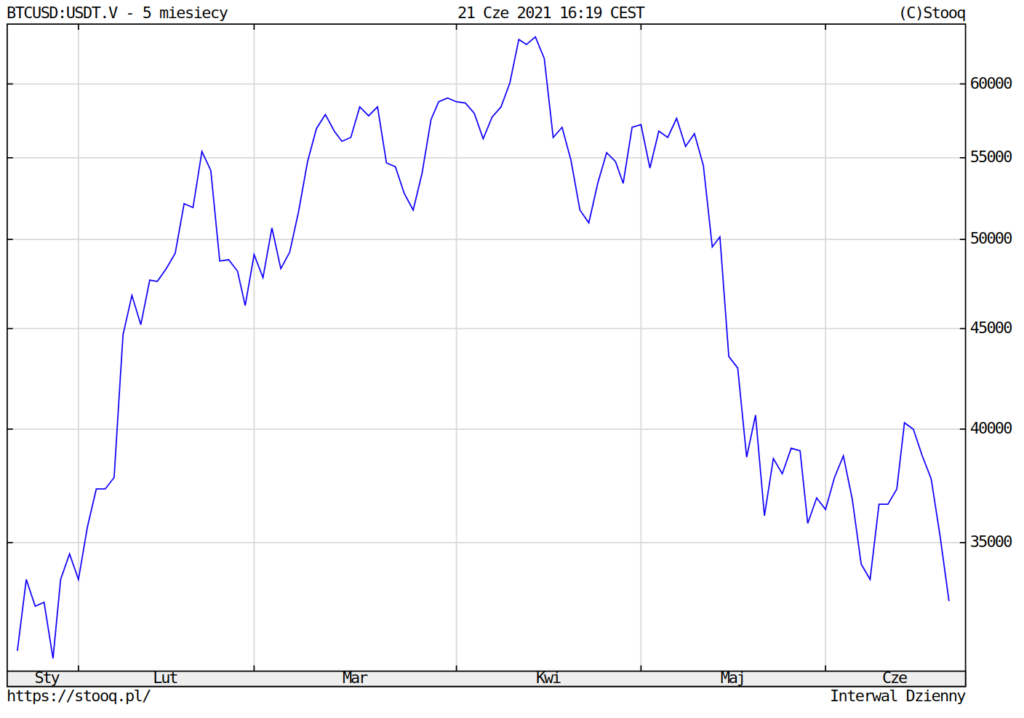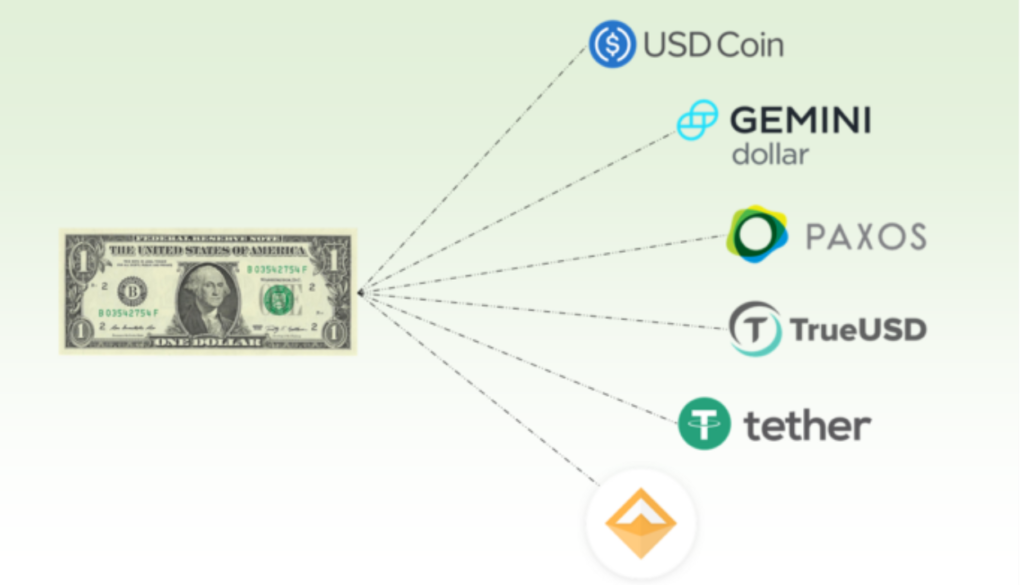What are stablecoins?
A stablecoin is a cryptocurrency that maintains a stable value. This stability is achieved by pegging the token to another stable asset, usually a fiat currency (US dollar, euro, British pound, etc.). However, a stablecoin’s value can also be fixed to e.g. an ounce of gold or a basket of various assets (e.g. SDR).
Fiat money (or fiduciary money, from Latin fides meaning faith) – a currency that is not backed by any physical asset (such as a bullion). The value of fiat money is based on trust in its issuer.
Wikipedia
Stablecoins were created to address the considerable volatility of cryptocurrencies. To give you an example, the price of Bitcoin can fluctuate by over a dozen percent within just one hour! Why would anyone want to buy anything with a coin that can be worth half as much the next day? And why would anyone accept payment in a cryptocurrency that may nosedive as the transaction is being confirmed?

The volatility of cryptocurrencies is one of the most significant barriers to their mass adoption as a medium of exchange or store of value.
Stablecoin categories
The blockchain ecosystem is quite extensive and thus offers many functioning stablecoins. Depending on their design, these projects can be classified into several groups.
Fiat-backed coins
Stablecoins backed by traditional fiat currencies (e.g. the US dollar). These store a certain amount of money in a bank account as a backing reserve for the issued coins. The most common peg is 1:1, i.e. 1 unit of cryptocurrency in circulation corresponds to 1 unit of the underlying fiat currency (e.g. USD 1, EUR 1 or GBP 1). For example, if the backing reserve is USD 100 million, there will be 100 million stablecoins in circulation, each worth USD 1. By increasing the reserve, the custodian can issue new coins (increasing the supply). Upon request, the company operating the given stablecoin redeems the coins and returns the fiat currency (reducing the supply).

The reserve is managed by a centralized party which in theory guarantees coverage of the coins in circulation by the reserve. Reserves are subject to audits from various financial institutions depending on the residence of the company managing the given stablecoin.
| Advantages | Disadvantages |
|---|---|
| Minimal price fluctuations | Centralized |
| High liquidity | Reliable coverage through backing reserve |
Commodity-backed
Just as in the case of fiat-backed stablecoins, commodities (i.e. gold, silver, oil, etc.) are stored in warehouses and serve as a backing reserve for the issued cryptocurrencies.
The XAUt (Tether Gold) stablecoin is a coin collateralized with physical gold bars deposited in Switzerland. One XAUt token represents one ounce of gold (31.1 grams). The coins can be exchanged for an actual gold bar, delivered to a selected location in Switzerland. The second option is to sell the gold and receive US dollars. In both cases, your account must be verified with TG Commodities Limited and hold the required number of XAUt corresponding to the value of a Good Delivery standard gold bar.
| Advantages | Disadvantages |
|---|---|
| Minimal price fluctuations | Centralized |
| High liquidity | Reliable coverage through backing reserve |
Cryptocurrency-backed
In this case, the collateral comprises other cryptocurrencies, typically those with the highest market cap (Bitcoin, Ethereum). The advantage of such stablecoins is the lack of a central party managing the project and its reserves. Decentralization is achieved through smart contracts that take a user’s deposit as collateral against the issued stablecoins.
Cryptocurrency backing (e.g. with BTC, ETH) is, however, problematic due to massive price fluctuations. So how to maintain a stable 1:1 peg to e.g. the US Dollar? This problem was solved through redundant collateral. Any user who wants to receive stablecoins must transfer collateral of a correspondingly higher value to the smart contract address. This way, if the price of the backing cryptocurrencies falls, the position will be secured through redundancy.
A deposit equal to 200% of the value of issued stablecoins will protect us from a 50% decrease in the value of our collateral. For example, to buy 1 stablecoin worth USD 1, we need to deposit ETH tokens worth USD 2 with the transaction. However, if the value of the collateral drops by more than 50%, our collateral will be liquidated!
| Advantages | Disadvantages |
|---|---|
| Decentralized | Redundant collateral |
| Transparency | Less stable price |
| Supply scalability | Risk of losing collateral given a major loss in price |
Seigniorage-style
These stablecoins employ a completely different approach to ensuring a peg between the coin and the underlying asset without a backing reserve. Price stabilization is ensured by sophisticated algorithms in conjunction with smart contracts, which simulate a monetary policy by manipulating the supply of stablecoins in circulation by “printing” or “burning” them depending on the market situation. During peak demand times, the algorithms increase the supply of coins in circulation to prevent their price from rising and maintain a peg to the selected asset (e.g. USD). When demand drops, excess stablecoins are burned (thus, the supply is reduced) to stop their price from falling.
| Advantages | Disadvantages |
|---|---|
| Decentralized | Complex underlying algorithms |
| No backing reserve | Less stable price |
List of projects
Below is a list of stablecoins with the highest market cap in each category.
| Stablecoin | Ticker | PEG | Collateral |
|---|---|---|---|
| Tether | USDT | USD | Fiat |
| USD Coin | USDC | USD | Fiat |
| Binance USD | BUSD | USD | Fiat |
| Dai | DAI | USD | Crypto |
| Algorithm | |||
| TrueUSD | TUSD | USD | Fiat |
| Paxos Standard | PAX | USD | Fiat |
| Tether Gold | XAUT | Gold ounce | Commodity |
| Paxos Gold | PAXG | Gold ounce | Commodity |
Summary
When using stablecoins, keep in mind that their price reflects the stability of the asset to which it is pegged. And though, for example, the US dollar exchange rate is stable, this does not always have to be the case, especially in the long run.
Stablecoins have undoubtedly brought a new quality to the crypto world. However, you should always exercise caution when selecting individual projects. Always remember that the main goal of Bitcoin, the first blockchain-based cryptocurrency, was to facilitate direct transactions between two parties without the involvement of an intermediary. However, some stablecoins go against this idea and are operated by third parties.



